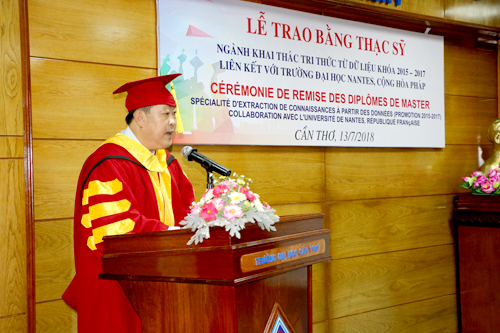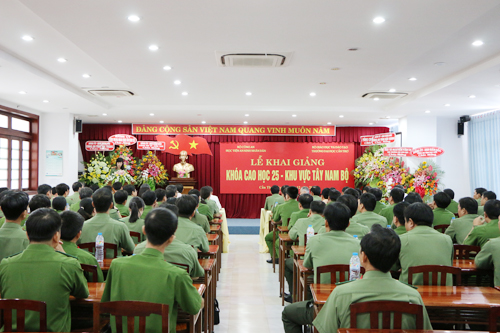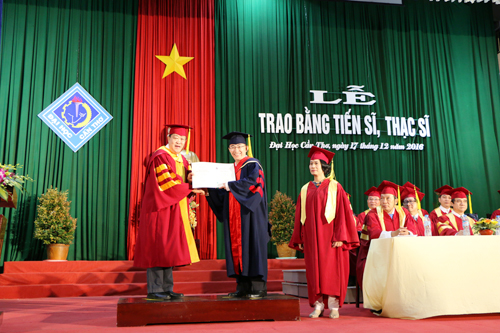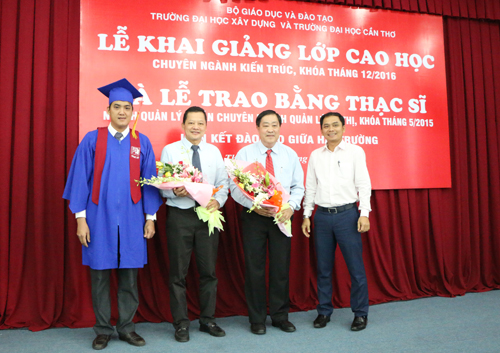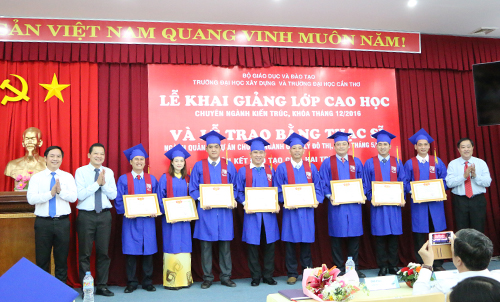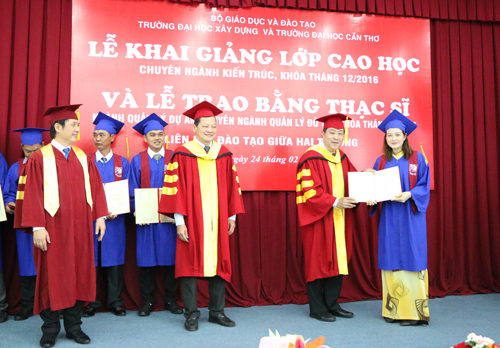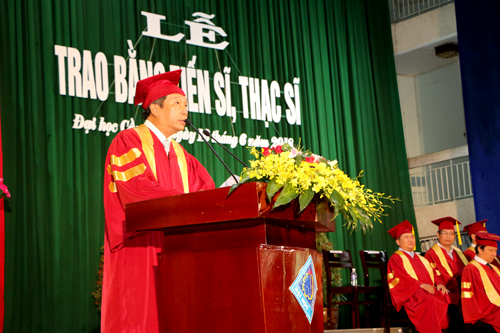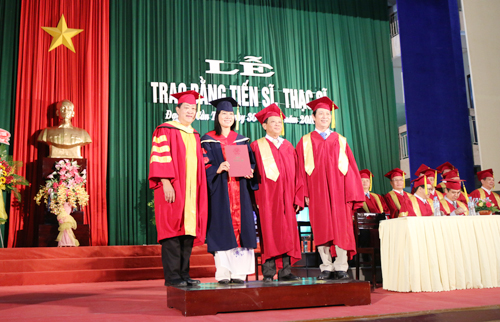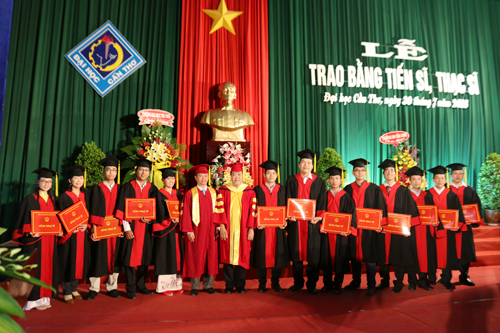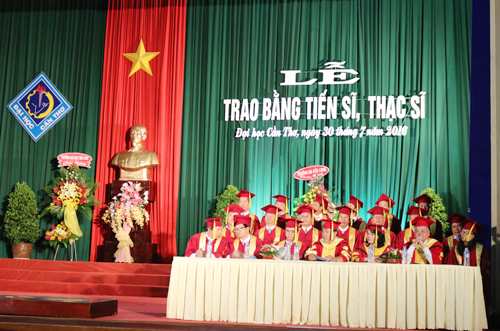
Tên đề tài: “Nghiên cứu sản xuất và thử nghiệm hoạt tính sinh học của quả thể nấm vân chi đỏ (Pycnoporus sp.) từ phụ phế phẩm nông nghiệp”.
Tác giả: Trần Đức Tường, Khóa: 2015
Chuyên ngành: Công nghệ sinh học; Mã số: 62420201. Nhóm ngành: Khoa học sự sống.
Người hướng dẫn chính: TS. Bùi Thị Minh Diệu - Trường Đại học Cần Thơ
Người hướng dẫn phụ: PGS.TS. Dương Xuân Chữ - Trường Đại học Y Dược Cần Thơ
- Tóm tắt nội dung luận án
Luận án “Nghiên cứu sản xuất và thử nghiệm hoạt tính sinh học của quả thể nấm vân chi đỏ (Pycnoporus sp.) từ phụ phế phẩm nông nghiệp” nhằm xác định khả năng thay thế mùn cưa cây cao su bằng phụ phế phẩm nông nghiệp của vùng Đồng bằng sông Cửu Long để thiết kế quy trình trồng nấm vân chi đỏ đạt năng suất, chất lượng, hiệu quả cao. Đồng thời đánh giá sự an toàn, hoạt tính sinh học của cao chiết quả thể nấm.
Nấm vân chi đỏ thu thập từ tỉnh Tây Ninh, Việt Nam, dựa vào trình tự DNA vùng ITS 606 bp và đặc điểm hình thái của hệ sợi, quả thể nấm xác định được danh pháp khoa học Pycnoporus sanguineus (L.: Fr.) Murill MH225776.1.
Môi trường potato-dextrose-agar bổ sung 10% nước dừa thích hợp nhất cho sự phát triển của hệ sợi giống cấp 1. Không bổ sung thêm các thành phần dinh dưỡng vào môi trường hạt lúa hấp chín để nhân giống nấm cấp 2 và môi trường cọng khoai mì để nhân giống nấm cấp 3. Cùi bắp là phụ phế phẩm thích hợp nhất thay thế 50% mùn cưa cây cao su để thiết kế quy trình trồng nấm vân chi đỏ đạt năng suất cao nhất 103 g/bịch phôi với hiệu suất sinh học 34,2%, quả thể nấm đạt chất lượng tốt.
Nấm vân chi đỏ không gây độc tính cấp dựa vào ghi nhận không có chuột tử vong, không xác định được LD50 trên chuột uống cao chiết ethanol liều cao nhất 12.000 mg/kg thể trọng. Nấm này không gây độc tính bán trường diễn trên chuột uống cao chiết ethanol đến liều 1.000 mg/kg thể trọng liên tục 4 tuần. Cao chiết ethanol liều uống 500 mg/kg thể trọng đã có tác dụng giúp giảm đáng kể sự tăng các chỉ số cholesterol toàn phần, triglyceride, LDL-c huyết tương và MDA gan trên chuột bị gây tăng lipid máu, đồng thời giúp cải thiện sự sụt giảm GSH nên có tác dụng bảo vệ gan trước tổn thương do oxy hóa gây ra bởi tyloxapol.
Phương pháp đo quang phổ hấp thụ phân tử UV-Vis xác định được cao chiết ethanol chứa flavonoid, polyphenol, saponin, tannin, triterpenoid với lượng tương ứng 0,30; 26,62; 64,93; 0,17; 68,02 mg/g và cao chiết nước với lượng tương ứng 0,90; 30,20; 58,01; 0,04; 61,04 mg/g. Cao chiết ethanol và cao chiết nước khuếch tán qua giếng thạch có khả năng kháng lại vi khuẩn E. coli, P. aeruginosa, S. faecalis, S. aureus và K. Pneumoniae. Hoạt tính kháng oxy hoá của cao chiết ethanol thể hiện qua hiệu quả ức chế DPPH (IC50 = 196,68 µg/mL) và peroxy hoá lipid màng tế bào (IC50 = 975,84 µg/mL) cao hơn so với cao chiết nước (IC50 = 322,03 và 1311,24 µg/mL). Tiềm năng ổn định đường huyết của cao chiết ethanol thể hiện qua hiệu quả ức chế α-amylase (IC50 = 97,08 µg/mL) và α-glucosidase (IC50 = 92,60 µg/mL) cao hơn so với cao chiết nước (IC50 = 150,15 và 102,29 µg/mL).
- Những kết quả mới của luận án
Luận án đã xác định được danh pháp khoa học của nấm vân chi đỏ là Pycnoporus sanguineus (L.: Fr.) Murrill, với mã nhận biết đặc hiệu (accession number: MH225776.1).
Luận án đã thiết kế thành công quy trình trồng nấm vân chi đỏ cho năng suất, chất lượng và hiệu quả cao từ phụ phế phẩm nông nghiệp của vùng Đồng bằng sông Cửu Long. Đã xác định được cùi bắp là phụ phế phẩm phù hợp nhất so với vỏ tràm và vỏ trấu, có tiềm năng lớn thay thế cho mùn cưa cây cao su. Chưa có nghiên cứu nào trước đó về việc tận dụng phụ phế phẩm nông nghiệp của vùng Đồng bằng sông Cửu Long để trồng nấm vân chi đỏ.
Thực nghiệm đã xác định được quả thể nấm vân chi đỏ có hoạt tính kháng khuẩn, kháng oxy hoá, ổn định đường huyết, hạ lipid máu và an toàn sử dụng nên có tiềm năng lớn được sử dụng để bảo vệ sức khoẻ.
Luận án còn là tài liệu tham khảo tốt cho các nghiên cứu tiếp theo, tài liệu giảng dạy cho các ngành nông học, công nghệ sinh học, dược liệu...
- Các ứng dụng/khả năng ứng dụng trong thực tiễn, các vấn đề cần tiếp tục nghiên cứu
Nghiên cứu xác định được danh pháp khoa học nấm vân chi đỏ, sử dụng hiệu quả phụ phế phẩm nông nghiệp có trữ lượng dồi dào, luôn sẵn có ở Đồng bằng sông Cửu Long để trồng nấm vân chi đỏ, có giá trị dược liệu tốt và an toàn sử dụng.
Kết quả nghiên cứu mang đến cho người dân giá trị của nguồn dược liệu quý đạt chất lượng, hiệu quả kinh tế cao, giúp giảm thiểu ô nhiễm môi trường do phát thải nông nghiệp gây ra, đồng thời giúp tăng thu nhập cho nông dân trồng nấm, góp phần thực hiện tốt đề án tái cơ cấu ngành nông nghiệp của vùng Đồng bằng sông Cửu Long.
Đề nghị thúc đẩy sản xuất đại trà nấm vân chi đỏ trên cùi bắp thay thế cho 50% mùn cưa cây cao su và tiếp tục nghiên cứu để hướng tới sản xuất các chế phẩm bảo vệ sức khoẻ từ loại nấm này.
- Thesis summary
The thesis entitled "Study on production and testing of biological activity of Pycnoporus sp. mushroom’s fruiting bodies from agricultural waste and by-products" aims to determine the possibility of replacement of rubber sawdust by agricultural waste and by-products in the Pycnoporus sp. mushroom cultivation process with sufficient yield and quality in the Mekong Delta. Its extracts’ safety and some biological activities is also identified.
The Pycnoporus sanguineus MH225776.1 mushroom collected in Tay Ninh province of Vietnam was isolated and identified based on DNA sequencing of 606 bp ITS region, combined with morphological characteristics of trimitic hyphal system and basidiocarp.
The potato-dextrose-agar medium with coconut water (10%) added was the most suitable for the development of level 1 mycelium. In the second phase, steamed rice grain was the optimal substrate for mycelial growth. For the third phase, cassava stalks were the best medium for mycelial spreading. Corn cobs were the most suitable agricultural waste and by-product to replace 50% of rubber sawdust to give the highest yield (103 g/bag) with biological efficiency of 34.2% and good quality fruiting bodies.
There were no mice who died in the acute oral toxicity test at the highest dose (12,000 mg ethanolic extract/kg body weight). Sub-chronic oral toxicity was not found in the ethanolic extract at doses of 500 mg/kg and 1,000 mg/kg body weight in mice continuously for 4 weeks. An increase of total cholesterol, triglycerides and LDL-c with tyloxapol-induced hyperlipidemia in mice was inhibited at an oral dose of 500 mg/kg body weight of the ethanolic extract. In addition, MDA increase was diminished and GSH decrease due hepatic lesions in mice was improved.
The phytochemical compounds in the extracts such as flavonoids, polyphenols, saponins, tannins, and triterpenoids was determined and quantified by measuring UV-Vis molecular absorption spectroscopy. The phytochemical compounds contents in ethanolic extract were 0.30, 26.62, 64.93, 0.17, and 68.02 mg/g, respectively and in the aqueous extract were 0.90, 30.20, 58.01, 0.04, and 61.04 mg/g, respectively. The antimicrobial activities and minimum inhibitory concentrations (MIC) of ethanolic and aqueous extracts against pathogenic bacterial strains such as E. coli, P. aeruginosa, S. faecalis, S. aureus and K. pneumonia were determined by agar well diffusion and agar dilution methods. The antioxidant activity of P. sanguineus was evaluated via DPPH free radical scavenging and lipid peroxidation inhibition of the ethanolic and aqueous extracts from fruiting bodies. The inhibitory effect of ethanolic extract with IC50 values of 196.68 and 975.84 μg/mL was stronger than that of aqueous extract with IC50 values of 322.03 and 1311.24 μg/mL, respectively. The ethanolic and aqueous extracts from fruiting bodies were potential in hypoglycemic activity, proving by inhibitory activity on α-amylase and α-glucosidase enzymes. The inhibitory effect of ethanolic extract with IC50 values of 97.08 and 92.60 μg/mL was stronger than that of aqueous extract with IC50 values of 150.15 and 102.29 μg/mL, respectively.
- New results of the thesis
The thesis has identified the scientific nomenclature of the mushroom strain in this study was Pycnoporus sanguineus (L.: Fr.) Murrill, with accession number MH225776.1.
The thesis has successfully designed the Pycnoporus sanguineus mushroom cultivation process with sufficient yield and quality from agricultural waste and by-product in the Mekong Delta. Corn cobs was the most suitable agricultural waste and by-product compared with melaleuca bark and rice husk has great potential to replace rubber sawdust. There are no previous studies on the utilization of agricultural waste and by-product of the Mekong Delta to cultivate Pycnoporus sanguineus.
The experiment has determined that Pycnoporus sanguineus mushroom’s fruiting bodies to have antibacterial, antioxidant, hypoglycemic, antihyperlipidemic activities and safe to use, so it has the potential to be used to protect health.
The thesis is also a good reference for the next studies, teaching materials for agronomy, biotechnology, pharmaceuticals...
- Application prospect and suggestions for further study
This study has identified the scientific nomenclature of the Pycnoporus sp. mushroom, effectively utilization of these agricultural wastes and by-products replacing of rubber sawdust with abundant reserves, available in the Mekong Delta to cultivate Pycnoporus sp. mushroom, with good medicinal values and safe to use.
The obtained results gives the people the value of quality medicinal herbs with high economic efficiency, helps to reduce environmental pollution caused by agricultural emissions, and at the same time helps increase revenue. import for farmers to grow mushrooms, contributing to the implementation of the project of agricultural restructuring in the Mekong Delta.
Suggest to promote mass production of P. sanguineus mushroom on corn cobs to replace 50% of rubber sawdust and continue to research towards the production of health protection products from this mushroom.
- Xem chi tiết nội dung luận án
- Xem thông tin đăng tải tại Website Bộ giáo dục và Đào tạo. (Nhập tên NCS vào ô tìm kiếm)





